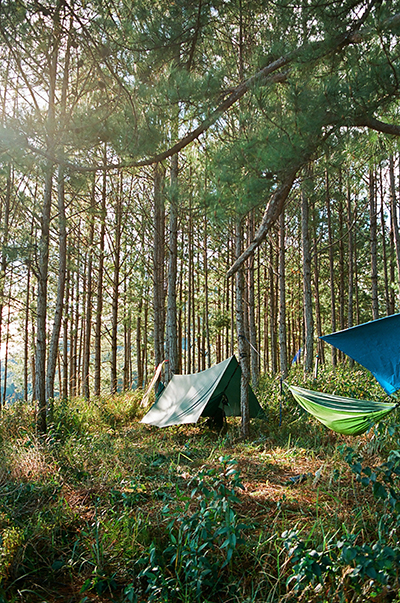Are you planning to go on a hammock camping trip in the backcountry? While it can be a fun and relaxing way to spend time in nature, it’s important to know the dos and don’ts to ensure a successful trip. In this article, we’ll cover common mistakes to avoid and best practices to follow when hammock camping in the backcountry.
What is Hammock Camping?
Hammock camping is a type of camping where you sleep in a hammock instead of a tent. It’s becoming increasingly popular among outdoor enthusiasts due to its portability and ease of setup. Hammock camping allows you to sleep off the ground, which can be more comfortable and provide a better view of your surroundings.
If you’re camping, why not get your hammock? Hammock camping has become increasingly popular in recent years and for good reason. The benefits of hammock camping are numerous – you can hang a hammock almost anywhere, it’s one of the most comfortable ways to sleep in the great outdoors, and it’s a unique camping experience that sets you apart from the tent campers. But, if you’re new to hammock camping, you need to keep some do’s and don’ts in mind. Expert hammock camping tips can help you stay warm in a hammock, attach your hammock properly, and make your hammock comfortable for sleeping. One of the most important things to remember is to find sturdy trees to hang your hammock. Make sure there are enough trees with the right width for your hammock, and hang it with the foot end slightly higher than the head end. Use a pad inside your hammock to keep you comfortable and a rain fly to keep it dry if it rains. And if you’re camping for the first time, a step-by-step guide and expert tips can make all the difference in your hammock camping experience. So, the next time you plan a camping trip, consider opting for a hammock instead of a tent and enjoy the benefits of hammock camping.

The Dos of Hammock Camping
- Do check the weather forecast before you go. Knowing the weather conditions can help you plan what gear to bring and what clothes to wear.
- Do invest in a high-quality hammock. A good hammock can provide comfort, support, and durability. Look for hammocks made from durable materials, such as ripstop nylon or polyester, with a weight capacity that can support your body weight.
- Do you practice setting up your hammock before your trip? Familiarizing yourself with the setup process can save you time and frustration when you’re out in the backcountry.
- Do bring a rainfly or tarp. This can protect you from rain and wind and provide shade during sunny days.
- Do pack a warm sleeping bag or quilt. Even in warm weather, temperatures can drop at night, so it’s important to have adequate insulation.
- Do follow Leave No Trace principles. This means packing out all of your trash, minimizing environmental impact, and respecting wildlife.
The Don’ts of Hammock Camping
- Don’t hang your hammock too high off the ground. A good rule of thumb is to hang your hammock no more than 18 inches off the ground to minimize the risk of injury if you fall.
- Don’t hang your hammock from dead or weak trees. This can be dangerous and can cause damage to the trees. Look for healthy, living trees with a diameter of at least 6 inches.
- Don’t overpack. Hammock camping is meant to be lightweight and portable, so pack only the essentials.
- Don’t forget to bring a bug net. Mosquitoes and other insects can be a nuisance, so having a bug net to protect yourself is important.
- Don’t camp in prohibited areas. Check the rules and regulations of the area you’re camping in to avoid any legal issues.
- Don’t leave food or scented items in your hammock. This can attract wildlife and pose a safety risk.

Hammock Camping Tips for Beginners
If you’re new to hammock camping, you should keep a few things in mind to ensure you have a safe and comfortable experience. Here are some expert tips for getting started with hammock camping:
- Choose the Right Hammock
When selecting a hammock for camping, choosing one made specifically for this purpose is important. Look for a durable hammock with sturdy straps and easy to set up and take down. Avoid using indoor hammocks or those that are not designed for outdoor use, as they may not be strong enough to support your weight or withstand the elements.
- Hang Your Hammock Properly
To ensure a comfortable and safe sleeping experience, it’s essential to hang your hammock correctly. Make sure to choose two strong and healthy trees or other support structures that are at least 10-15 feet apart. You should also use straps or webbing to hang your hammock rather than ropes, which can cause damage to trees.
- Use a Sleeping Pad
To stay warm and comfortable while sleeping in your hammock, it’s important to use a sleeping pad. This will help to insulate you from the cold air underneath your hammock and provide additional cushioning for your back.
- Bring a Tarp and Bug Net
A tarp and bug net are essential items to bring with you when hammock camping. The tarp will help to protect you from rain and wind, while the bug net will keep mosquitoes and other insects at bay.
Benefits of Hammock Camping
One of the biggest benefits of hammock camping is that it can be more comfortable than sleeping in a tent on the ground. Hammocks conform to your body and can help you sleep better. Additionally, since you’re off the ground, you don’t have to worry about rocky or uneven terrain, and you can avoid any critters that may be crawling around on the forest floor. Hammocks are also lightweight and portable, making them a great option for backpackers or those who want to travel light with tree straps.
Hammock Camping FAQ
- Q: Can I hammock camp in cold weather? A: Yes, you can hammock camp in cold weather, but you’ll need to bring appropriate gear, such as a warm sleeping bag and insulation.
- Q: How do I set up my hammock in the backcountry? A: Look for two trees that are about 10 to 15 feet apart, and hang your hammock using straps or ropes.
- Q: Can I hammock camp in bear country? A: Yes, but following proper bear safety precautions is important, such as storing food in a bear-resistant container and hanging it at least 10 feet off the ground.
- Q: What kind of hammock should I buy for camping? A: Look for a hammock made from durable materials, such as ripstop nylon

